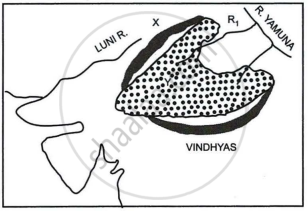Advertisements
Advertisements
Question
Study the sketch map given below and answer the questions that follow:

- Identify the dotted region marked Y. Mention any three of its characteristic features.
- Name the mountain range marked X, the river marked R1 and the type of rock that constitutes the dotted region.
Solution
- The Malwa Plateau is shown on the map as the dotted area.
This region has three key characteristics:- One example of a piedmont plateau is the Malwa plateau. The Deccan Traps, which were formed between 60 and 68 million years ago, are extended by the plateau. The Malwa Plateau is 500 meters above sea level on average.
- It was created by intense volcanic activity that occurred 66 million years ago. The soil is black and fertile.
- The rivers Chambal, Sipra, Kali Sindh, and Parbati drain the gently sloping Malwa plateau to the north.
- On the plateau, the area is covered in savanna-type vegetation, and in the southern portion, on the spurs of the Vindhya and Satpura ranges, it is covered in moist deciduous forests.
- X: Aravalli Range, R1: Chambal and Type of rock in the dotted region: Igneous rocks (primarily basalt)
APPEARS IN
RELATED QUESTIONS
Name the four Indian geological eras in their chronological order.
Answer the following question:
The figure below represents a topographic section from the Himalayas to the Peninsular region. Identify any two of the features marked A, B, C, and D.
Answer the following question.
Give three differences between the Western and the Eastern Himalayas.
Name any two standard geological eras, along with their duration.
Answer the following question.
Explain the formation of Himalayas with reference to the theory of Plate Tectonics.
Mention any two characteristic features of the Peninsular Plateau of India.
Answer the following question:
The figure below represents a section from the Aravalis to the Peninsular region.

Identify any two of the relief features marked, A, B, C, and D.
Name the following :
A historic place in Rajasthan.
The main Standard geological era is ______.
Assertion: The Himalayas were formed due to the collision of tectonic plates.
Reason: Indian plate moved northwards and pushed beneath the Eurasian Plate leading to the compression of sediments in the Tethys Sea.
